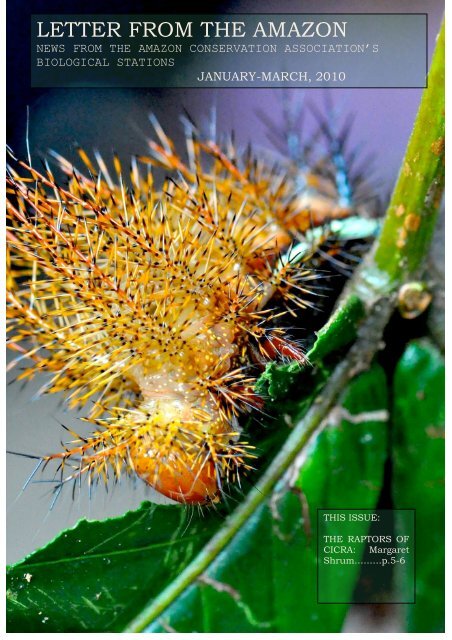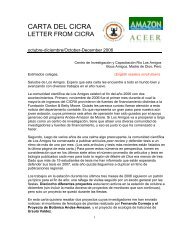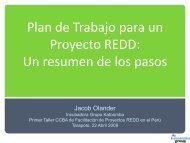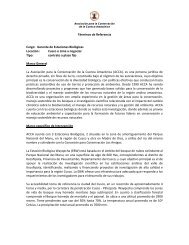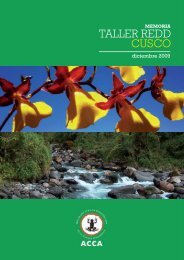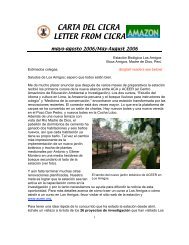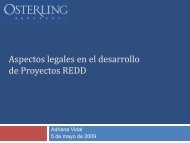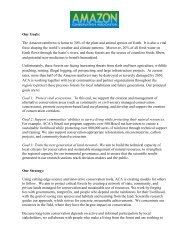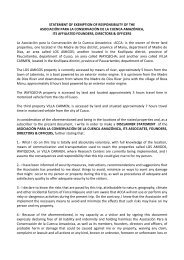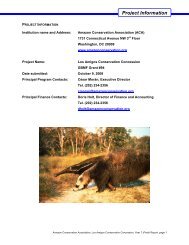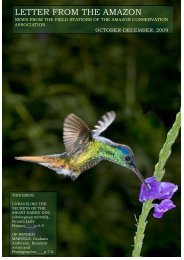LETTER FROM THE AMAZON - Amazon Conservation Association
LETTER FROM THE AMAZON - Amazon Conservation Association
LETTER FROM THE AMAZON - Amazon Conservation Association
Create successful ePaper yourself
Turn your PDF publications into a flip-book with our unique Google optimized e-Paper software.
]<br />
<strong>LETTER</strong> <strong>FROM</strong> <strong>THE</strong> <strong>AMAZON</strong><br />
NEWS <strong>FROM</strong> <strong>THE</strong> <strong>AMAZON</strong> CONSERVATION ASSOCIATION’S<br />
BIOLOGICAL STATIONS<br />
JANUARY-MARCH, 2010<br />
THIS ISSUE:<br />
<strong>THE</strong> RAPTORS OF<br />
CICRA: Margaret<br />
Shrum………p.5-6
Letter from the <strong>Amazon</strong> January-March, 2010<br />
Contents:<br />
Cover: the “awesome caterpillar” spotlighted in<br />
“Jungle News,” a short video series by CICRA<br />
resident artist Lucy Cooke (spotlight p. 3). Photo by<br />
Sarah Federman.<br />
Page 3: Letter from the director:<br />
Page 4: Current research, CICRA and Wayqecha<br />
Page 5: Margaret Shrum: The Raptors of CICRA<br />
Page 7: Research: recent publications, CICRA and<br />
Wayqecha<br />
Page 8: Staff, Community, and News, CICRA and<br />
Wayqecha<br />
Page 9: Long term visitors, recent arrivals, and<br />
courses, CICRA and Wayqecha<br />
Page 10: Publications this trimester, CICRA and<br />
Wayqecha<br />
Page 11: About our stations, CICRA and<br />
Wayqecha<br />
Macaws at CM1 by Sarah Federman<br />
Our Contributors:<br />
This issue’s special editorial from CICRA:<br />
Margaret Shrum: A PhD<br />
candidate at Clemson<br />
University, Margaret<br />
studies mercury<br />
accumulation in birds of<br />
prey at CICRA. This issue,<br />
Margaret has contributed<br />
the editorial The Raptors of CICRA (p.5), which<br />
speaks about her doctoral research.<br />
Permanent fixtures:<br />
Sarah Carbonel: A candidate for her<br />
licenciatura (certification as a<br />
biologist) at San Marcos University,<br />
and CICRA’s assistant logistics<br />
coordinator, Sarah is interested in<br />
the relationship between beetles and<br />
their host plants.<br />
Sarah Federman: A fellow from<br />
Princeton in Latin America, Sarah is<br />
CICRA’s assistant research<br />
coordinator. She is interested in<br />
dispersal ecology and forest stand<br />
regeneration in areas impacted by<br />
human presence.<br />
Laura Morales: A fellow from<br />
Princeton in Latin America with<br />
Wayqecha, Laura is interested in the<br />
ecology of watersheds and water<br />
quality.<br />
Adrian Tejedor: CICRA and<br />
Wayqecha’s director of research,<br />
Adrian is interested in bat evolution,<br />
ecology, and biogeography.
Letter from the <strong>Amazon</strong> January-March, 2010<br />
Fins and Feathers<br />
Letter from the director:<br />
Dr. Adrian Tejedor, Director of Research<br />
How does a research station benefit me? Why should I<br />
care about science? One reason these questions always<br />
crop up is that the answer is not straightforward. The<br />
benefits of science surround us in agriculture,<br />
technology, and medicine but the link between the<br />
original bits of discovery and their practical applications<br />
is rarely direct or well publicized.<br />
How many hundreds of millions of us owe our existence<br />
to the penicillin used by our ancestors - only one or two<br />
generations back - to cure infections that before the<br />
1950s were life-threatening? Who could have foreseen<br />
that this savior antibiotic would come from a mold whose<br />
effects were discovered by serendipity and put to work<br />
only 20 years later? Given enough time, the rummaging<br />
of scientists, often demeaned by non-specialists as the<br />
search of the ‘leg of an ant, the fin of a little fish, or the<br />
feather of a bird’, can have momentous consequences<br />
for the quality of life of everyone on Earth.<br />
Macaws, renowned for their beautiful feathers, by Sarah<br />
Federman.<br />
At its research stations, CICRA and Wayqecha, ACCA<br />
seeks to foster both pure and applied science to solve<br />
the most pressing environmental issues of the southern<br />
Peruvian <strong>Amazon</strong> and the Andean cloud forest. In<br />
addition to updates of the many projects and activities at<br />
our stations, in this issue of the Letter from the <strong>Amazon</strong>,<br />
you will find answers to one of the region’s most urgent<br />
questions: how badly is mercury, used in gold mining in<br />
the Madre de Dios River, contaminating aquatic and<br />
terrestrial ecosystems? The evidence has come from, of<br />
all things, fi ns and feathers.<br />
Looking at the muscle at the base of the dorsal fin of<br />
fish, CICRA’s grant program awardee Dr. Luis<br />
Fernandez has figured out to what degree river fish, an<br />
important source of protein in the <strong>Amazon</strong>, are being<br />
contaminated by mercury. As you will read, the little fish<br />
turn out to be the least contaminated and the best to eat.<br />
Madre de Dios River by Sarah Federman.<br />
Feathers, on the other hand, show us that mercury is<br />
traveling away from the rivers through the food chain.<br />
This story is told by Margaret (Peggy) Shrum, a longterm<br />
researcher at CICRA who has discovered<br />
potentially lethal concentrations of this toxic metal in the<br />
<strong>Amazon</strong>’s top aerial predators: birds of prey. If this<br />
pattern repeats in terrestrial food chains, it may indicate<br />
that mercury contamination, with origins in river mining,<br />
could reach further into terrestrial ecosystems and<br />
persist for a longer time than previously realized.<br />
These examples demonstrate that science can help us<br />
make sensible choices when deciding what to eat or<br />
where to look for what we eat in the Peruvian <strong>Amazon</strong>.<br />
So then, should we fund scientists proposing to study<br />
legs, fins, or feathers? I think we should.<br />
The Andes glimpsed beyond the rainforest’s canopy; a sight to<br />
revel in, a view worth protecting, by Sarah Federman.<br />
3
Letter from the <strong>Amazon</strong> January-March, 2010<br />
Research: current stories<br />
CICRA<br />
Of fieldwork and teamwork<br />
Mrilani Watsa’s project on chimersim and population<br />
genetics and their correlates with<br />
affiliative behaviour in pichicos (Saguinus<br />
f. weddelli), really picked up this trimester<br />
with the addition of 3 new dedicated<br />
assistants to the project. The pichiqueros,<br />
now consisting of six team members,<br />
work hard, heading out at 5:00 am and<br />
often returning at 5:00 pm. They caught (literally) and<br />
processed one more pichico twin as it fell from the<br />
canopy in a poorly calculated jump. This trimester Mini<br />
and her team have been formulating and testing a few<br />
new trapping strategies to optimize the captures of<br />
CICRA’s pichicos. Best of luck to Mini and the<br />
pichiqueros! Follow Mini at: www.primatesperu.com.<br />
Sarah Federman. Pichicos by Sarah Carbonel.<br />
Lucy Cooke: Resident Artist<br />
Lucy, an experienced documentary filmmaker, is also<br />
an amphibian conservation enthusiast. Her desire to<br />
make accessible to a wide audience the fantastic<br />
world of frogs, the chytrid blight, and the many<br />
obstacles facing amphibian conservation, brought her<br />
to CICRA for the month of January. Here she spent a<br />
month documenting the long-term research going on<br />
by shadowing investigators, as well as frogging in her<br />
free evenings; lucky for her that she came in our rainy<br />
season. One of Lucy’s many contributions to CICRA<br />
during her stay was the direction and filming of<br />
Jungle News, a short series about life at CICRA<br />
(CICRA is featured in Lucy’s piece in The Telegraph<br />
International in print as well as their online edition,<br />
complete with video clips titled: My Scatological<br />
Jungle Adventure (www.telegraph.co.uk/expat/7429086/Myscatological-jungle-adventure.html).<br />
Lucy’s quest was brought<br />
closer to its realization when the BBC began<br />
overtures regarding the possibility of making a<br />
documentary with her on the chytrid crises! Follow<br />
Lucy on her amphibian-oriented odyssey:<br />
http://pinktreefrog.typepad.com/amphibianavenger/. Sarah<br />
Federman. Lucy with frog, Sarah Federman<br />
Sarah Carbonel: the “Sarah” in Cerambycidae<br />
Sarah, as highlighted in our last issue (p. 10), is<br />
completing her Biology degree at San<br />
Marco’s University in Zoology. Her focus is<br />
on the association between long-horned<br />
beetles and their Sapotaceae host trees.<br />
Sarah has had 50 bags of harvested<br />
Sapotaceae wood housed in her ‘beetle<br />
house’ out near CICRA’s staff dorms for<br />
over one year. She scours each one with the zeal that<br />
only a true entomological enthusiast can muster to<br />
collect any and all traces of beetle. She plans to identify<br />
her specimens in Lima to better understand host<br />
specificity. Sarah Federman. Isthimiade sp. by Jose Roque.<br />
Wayqecha<br />
Secondary effects of climate change<br />
The alteration of plant distribution ranges<br />
due to climate change could affect<br />
herbivore communities, which would in<br />
turn affect their impact on the vegetation.<br />
In mountain ecosystems, such as cloud<br />
forests, vegetation is projected to be<br />
visited by higher numbers of insects.<br />
Seedling response to these increased rates of herbivory<br />
is essential for these populations’ survival. Richard Tito<br />
(UNSAAC) studies Weinmannia bangui seedlings<br />
transplanted to different elevations to investigate<br />
changes in herbivory levels as related to the distance<br />
from their current distribution range. He aims to project<br />
plant responses to changes in the ecological relations<br />
with herbivores caused by climate change. Laura<br />
Morales. Polygalaceae by Virginia Boyce.<br />
But it’s just a little cow…<br />
Vegetation, along with fauna, is expected to<br />
migrate upslope in response to climate<br />
change, but there are human factors that<br />
could impede this movement. In the cloud<br />
forests of Peru, cattle grazing by high-<br />
Andean farmers is a factor which puts<br />
vegetative migration at double risk: the<br />
burning of plots of forest to generate new<br />
grass, and grazing on said grass which also<br />
destroys surrounding vegetation. Under the<br />
sponsorship of NORAD, Marlene Mamani<br />
(ACCA) and Angela Rozo (UNSAAC) are<br />
undertaking a study with 5 inclusion and<br />
exclusion plots at the forest-grassland<br />
(puna) ecotone to quantify how grazing by<br />
local cattle affects the growth and<br />
colonization by the forest. The study will be<br />
carried out for 6 months in order to<br />
determine is if cattle could really act as<br />
impediments for the migration and<br />
development of the forest towards higher<br />
land. Laura Morales. Cows at Wayqecha by<br />
Laura Morales.<br />
.<br />
Frogs in the Face of Global Warming<br />
As with many other mountain fauna, Andean<br />
frogs will be rapidly affected by global warming.<br />
The temperature increase could affect their<br />
metabolism, infection rates, and have repercussions on<br />
their behavior. Yet the response of any particular<br />
population of frogs to such a change is unknown.<br />
Simulating warming, Sandra Almeyda (Univesidad<br />
Nacional Agraria de la Molina), has transferred<br />
Psychrophrynella usurpator frogs from a population<br />
native to 3400masl to 2900 masl, and will follow their<br />
mortality, physical conditions, and call rates for a year in<br />
comparison to a local population. She hopes to evaluate<br />
any differences that arise between the two populations.<br />
Laura Morales. Measuring a frog, by Laura Morales.<br />
4<br />
SPOTLIGHTS
Letter from the <strong>Amazon</strong> January-March, 2010<br />
The Raptors of CICRA<br />
While working as a field assistant for Ursula Valdez<br />
in 2004 and 2005, I noticed that the mining along<br />
the river Madre de Dios had almost tripled over the<br />
course of the year. Because the miners use<br />
mercury to extract gold from the sediment, I began<br />
to wonder about the presence of mercury in the<br />
area, and particularly its effect upon the wildlife.<br />
Because mercury bio-concentrates over the lifetime<br />
of an individual, and bio-magnifies in the food web,<br />
top predators like raptors are ideal for diagnosing<br />
and monitoring mercury contamination in the<br />
ecosystem. In August of 2006, along with my<br />
collaborator Juan Carlos Galvez, I began a study to<br />
measure and monitor mercury levels in the raptors<br />
of Los Amigos.<br />
Mercury is one of the most toxic substances on<br />
earth. It is a teratogen (causes birth defects), a<br />
mutagen (permanently changes genetic material), a<br />
carcinogen (causes cancer), and a neurotoxin<br />
(affects nerve tissue including the brain); it also<br />
causes blood chemistry and cytochemical changes.<br />
In birds, dietary mercury exposure can be directly<br />
lethal, or can have sub-lethal adverse effects on<br />
reproduction, growth and development, behavior,<br />
metabolism, and blood and tissue chemistry.<br />
In the field, we capture raptors using mist nets or<br />
Bal-Chatri (BC) traps and take blood and feather<br />
samples for mercury analysis. Feather sampling is<br />
an easy, non-invasive method of determining<br />
mercury levels because mercury is deposited in<br />
feathers as they grow. The concentration of<br />
mercury within the feather has a direct correlation<br />
with the individual’s mercury level. Samples are<br />
later analyzed at Clemson University.<br />
Roadside hawk (Buteo magnirostris); Margaret Shrum.<br />
5
Letter from the <strong>Amazon</strong> January-March, 2010<br />
We have captured 186 raptors from among 16<br />
species. The results indicate that these raptors are<br />
indeed carrying elevated levels of mercury, an<br />
indication of mercury contamination in the<br />
ecosystem. The birds sampled had levels ranging<br />
from 0ppm (n=5) to 10.1 ppm (n=1) with the<br />
majority ranging between 4.0 ppm and 6.0 ppm.<br />
While no toxic reference values exist for any of the<br />
species sampled, levels of greater than 1.0ppm<br />
have been shown to cause symptoms of mercury<br />
toxicity in birds; and levels of 5.0ppm have been<br />
shown to cause reproductive symptoms, even<br />
reproductive failure.<br />
The results of my study show that the raptors of<br />
Los Amigos are at risk for mercury toxicity, but<br />
because no toxic reference values exist, I am<br />
unable at this point to say how profound that risk<br />
may be. This unanswered question has taken my<br />
research in a new direction. My previous objective<br />
was simply to determine levels of mercury in the<br />
raptors. My new objective is to actually determine<br />
the risk that the mercury poses to the raptors. That<br />
is, I want to know if the levels that these birds have<br />
is significant enough to threaten their health and<br />
their reproductive success.<br />
Last November, I began placing radio transmitters<br />
on the tails of selected individuals in an attempt to<br />
find their nest and monitor their nesting success.<br />
Upon finding an active nest, I will be looking for<br />
things like poor hatchability, poor nest or nestling<br />
care (a behavioral change in adults), birth defects,<br />
and overall success or failure. I will be comparing<br />
nesting success or failure with the mercury levels in<br />
the adults to determine if a correlation exists.<br />
The overall success of my project is largely due to<br />
the assistance and field expertise of my partner,<br />
Rene Escudero. His help, insight and inspiration<br />
have been invaluable. I would also like to thank my<br />
many field assistants over the years; their help and<br />
companionship have been warmly appreciated.<br />
Thanks to Juan Carlos Galvez for all his help in<br />
making this project happen. Thanks also to Ursula<br />
Valdez, who introduced me both to the area and to<br />
the profession with enthusiasm and wisdom.<br />
Margaret Shrum<br />
Margaret and Rene with a captured Ornate Hawk Eagle.<br />
(Spizaetus ornatus) by Rene Escudero.<br />
6
Letter from the <strong>Amazon</strong> January-March, 2010<br />
RESEARCH: Recent<br />
Publications<br />
Mariajose Deza: arachnids of CICRA<br />
Mariajose received her BA from<br />
la Universidad Nacional Agraria<br />
la Molina. As an ACCA grantee,<br />
she studied the abundance and<br />
diversity of spiders (Aranaeidae)<br />
at CICRA for her certification as<br />
a biologist. Mariajose’s study,<br />
Diversity and species richness of the family Araneidae<br />
(Arachnida, Araneae) in CICRA (Madre de Dios—Peru)<br />
was completed and accepted for publication in Ecologia<br />
Aplicada this past year.<br />
Editorial continued below.<br />
Alison Ravenscraft: Ants and plants<br />
Alison Ravenscraft, Harvard ’09 was featured<br />
in our last letter in current research (p. 3).<br />
Many people traveling out to CICRA’s trail 6,<br />
especially in the crepuscular hours, return to<br />
the comedor with puzzled faces and questions<br />
about the ‘ghost town.’ Trail 6 has become a<br />
phantasmagorical trek through the woods. To<br />
exclude herbivores, Alison and her team have<br />
hung 52 large, white mosquito nets, each<br />
resting with an ethereal stateliness over their<br />
respective Cordia nodosa tree. The exclusions<br />
assess whether the plant invests a significant<br />
amount of resources in its resident ant colony.<br />
Ants defend the tree from the insects that eat<br />
it; but, if they are excluded, are ant colonies<br />
detrimental or beneficial to the tree? In<br />
January, Alison and one field assistant<br />
recently changed the mosquito nets of the<br />
ghost town; sadly, the new nets are a little<br />
more austere than the last ones, lacking the<br />
lovely aesthetic touch of the last bunch: a lacy<br />
fringe. Keep up with Alison and her adventures<br />
at holahormigas@blogspot.com. Sarah Federman.<br />
Photo of Alison at her ghost city by Sarah<br />
Federman.<br />
Mariajose collected over 4,000 individuals which were<br />
distributed across at least 25 genera and totaling 154<br />
species. Sarah Federman. Spider at CICRA by<br />
Katharine Fountain (top) Sarah Federman (bottom).<br />
New taxonomic classification of a frog from<br />
Wayqecha<br />
A small frog from the locality of<br />
Quebrada Toccoruyoc and Esperanza<br />
at Wayqecha Biological Station<br />
previously described and classified as<br />
“Hyla” antoniiochoai was reclassified<br />
into the genus Gastrotheca as a result of new specimen<br />
collections. Aside from general morphology, the<br />
advertisement call, morphological distinctions between<br />
adults and juveniles, and habitat have been described.<br />
Among the six new specimens collected were three<br />
juveniles and three adults. Among the adults was a<br />
brooding female, the first female collected as the authors<br />
believe the female reported in the previous study was<br />
actually a juvenile. Gastrotheca by Alessndro Catenazzi.<br />
Editorial continued below.<br />
To eat or not to eat<br />
Mercury used in gold mining pollutes the<br />
waters of Madre de Dios, and those who<br />
know it, often reject fish in restaurant<br />
menus. But, how much are the fish in<br />
Madre de Dios contaminated by mercury,<br />
really? That question was answered by<br />
Dr. Luis Fernandez, at the Carnegie<br />
Institution for Science. Funded in part by<br />
CICRA’s grant program. Dr. Fernandez<br />
determined the mercury content of dorsal<br />
muscle in eleven fish species and found<br />
that a single meal of the large<br />
carnivorous cat fish zumgaro (Zungaro<br />
zungaro) and mota (Calophysus<br />
macropterus) can overdose you with the<br />
heavy metal, while the smaller plant<br />
eating fish paco (Piaractus<br />
brachypomus) and boquichico<br />
(Prochilodus nigricans) are safe to eat.<br />
Good Friday followers will now know how<br />
to pick their fish. Stay tuned for results on<br />
more fish species soon. Adrian Tejedor.<br />
Photo: Looking for fish at the market. Puma<br />
zungaro (Pseudoplatystoma tigrinum) by Luis<br />
Fernandez.<br />
SPOTLIGHTS<br />
Characteristics which distinguish this frog from other<br />
Gastrotheca species are its comparatively small size and<br />
habitat of bromeliads. Some of the specimens in this<br />
collection were found in bromeliads over 6m high, about<br />
the height of Wayqecha’s<br />
canopy; this is the first report<br />
of a Gastrotheca at such<br />
heights. It is possible that they<br />
inhabit both the bromeliad<br />
habitat and brush. The frogs<br />
have an altitudinal range of<br />
2800-3300 masl, from which they appear to share part of<br />
their habitat with two other species of marsupial frogs in<br />
the region: G. excubitor and G. ochoai. Laura Morales.<br />
Juvenile Gastrotheca by Alessandro Catenazzi.<br />
7
Letter from the <strong>Amazon</strong> January-March, 2010<br />
Staff and community<br />
Staff member from Wayqecha<br />
Lucio Ccoyo Cordova works on the maintenance<br />
staff of Wayqecha. An inhabitant of the local<br />
community of Juan Alvarado Velasco de<br />
Sunchubamba, he is the station’s longest-serving<br />
staff member. Lucio has been with us for over five<br />
years, since Wayqecha’s beginning, working on<br />
construction and maintenance of the previous and<br />
current station. Lucio is the proud father of four<br />
daughters; outside the station he works in<br />
carpentry, a talent which he has applied to make<br />
some of the station’s furniture. Besides his talent in<br />
carpentry, Lucio is also known for his talent on a<br />
motorcycle. Laura Morales. Lucio by ACA.<br />
Weather at CICRA, 2009<br />
Rain in the rainforest? Shocking, we know.<br />
However, 2009 was our rainiest year since 2003,<br />
with a surprisingly low cumulative number, 176, of<br />
actual rainy days. Considering that models of<br />
climate change in the <strong>Amazon</strong> predict more net<br />
rain over less days, these statistics merit a second,<br />
and perhaps a third glance. Does this year<br />
represent typical variation for the area? Is global<br />
warming<br />
rearing its<br />
ponderous<br />
head? How<br />
do high levels<br />
of rain paired<br />
with low days<br />
impact the<br />
ecosystems<br />
and resident<br />
populations of our forest? Unfortunately, we do not<br />
have the answers to these pressing questions;<br />
though happily, we are in a position to make a<br />
difference through the recognition and continuation<br />
of the<br />
important<br />
research<br />
occurring at<br />
our<br />
biological<br />
research<br />
stations.<br />
This year,<br />
our rainy<br />
season coincides with an El Niño event, which<br />
traditionally brings less rain to the <strong>Amazon</strong>; we are<br />
interested to see what the weather holds. Sarah<br />
Federman.<br />
NEWS<br />
CICRA has unwittingly become the site of a new fashion craze: the musmuqui headpiece, everyone’s doing it, really. The story<br />
goes that one evening Marco, CICRA’s maintenance-man-extraordinaire, encountered a baby musmuqui (night monkey, Aotus<br />
nigriceps) wounded and wailing in the woods outside of the back cabins. It seems to have been a failed predation event, which<br />
caused him to fall from his mother’s back and to the ground. Whatever occurred to leave him on the ground, resulted in a baby<br />
monkey with hypothermia, a broken tibia, a laceration running from his spine to his belly, and a tail severely broken in two places.<br />
After a wonderful station-wide effort in emergency medical procedures, little Muqui, in defiance of everyone’s expectations, made<br />
it through that first night and is struggling on splendidly with Sarah Federman (or rather her hair) as a surrogate mother and<br />
primary caretaker. Sarah and Daniela Lainez of ACCA’s Puerto Maldonado office are working to find Muqui a permanent home,<br />
and in the interim to get him on a research permit at CICRA. The investigation aims to determine the inherency of musmuqui<br />
vocalizations versus the importance of imprinted vocalizations by examining responses of CICRA’s resident musmuqui<br />
populations to recordings of both Muqui and wild Aotus juveniles. Sarah Federman<br />
Muqui 1) Adrian Tejedor 2) Sarah Federman 3) Sarah Carbonel.<br />
8
Letter from the <strong>Amazon</strong> January-March, 2010<br />
Long-term projects<br />
CICRA<br />
Megan Frederickson, Antonio Coral, Alison Ravenscraft,<br />
and Lisseth Flores The economics of antplant<br />
mutualism in Cordia nodosa of the<br />
western <strong>Amazon</strong>. University of Toronto;<br />
Harvard University.<br />
Margaret Shrum, Rene Escudero, Alberto<br />
Escudero, and Yeverin Arimuya The impact<br />
of mercury contamination on birds of prey in<br />
the Peruvian <strong>Amazon</strong>. Clemson University.<br />
Sarah Carbonel Longhorned beetles in association with<br />
Sapotaceae at CICRA. Universidad Nacional Mayor de San<br />
Marcos.<br />
Sarah Federman Disperser<br />
response to anthropogenic<br />
disturbance of riparian<br />
succession in western <strong>Amazon</strong>ia.<br />
ACCA/Princeton University.<br />
Varun Swamy, Cesar Vela, and<br />
Ronald Suca, Successional<br />
regeneration and seed rain in a<br />
flood-plain of the Western <strong>Amazon</strong>. Duke University.<br />
Renata Leite Pitman and<br />
Emeterio Nuñecca Unraveling<br />
the secrets of the short-eared<br />
dog (Atelocynus microtis). Duke<br />
University.<br />
Mini Watsa, Gideon<br />
Erkenswick, Rhea Mac, Emma<br />
Wallace, Karina Klonoski, and Erin Kane Chimerism and<br />
population genetics of saddleback tamarins, Saguinus<br />
fuscicollis weddelli. Washington University.<br />
New Arrivals<br />
Carlos Martel Researcher: phenology<br />
of Chelyocarpus ulei.<br />
Lucy Cooke Artist in Residence:<br />
director and cinematographer of the<br />
short video series: “jungle news” as<br />
well as the author of “My scatological<br />
amazonian adventure” in the Telegraph<br />
International.<br />
Katherin Fountain volunteer, focus on creating a<br />
vegetable garden at CICRA.<br />
Photos: 1) Beautiful fungi by Katharine Fountain.2) The orchid<br />
and the bee by Katharine Fountain.3) Sunrise from the tower<br />
by Katharine Fountain. 4) Fly larvae by Sarah Federman.<br />
Wayqecha<br />
Matthias Dehling The behaviour and foraging patterns of birds<br />
for arboreal fruit in relation to an altitudinal gradient. University<br />
of Marburg.<br />
Adam Ccahuana. The dynamics<br />
of carbon emission and soil<br />
respiration in relation to landslides.<br />
ABERG.<br />
Kathryn Clark The role of<br />
landslides in the export of carbon<br />
from the Andes to the basins of<br />
Kcosñipata and Madre de Dios.<br />
Oxford University.<br />
Miguel Angel Luza Patterns in<br />
the spatial distribution of shrubs in<br />
scrubland. UNSAAC<br />
Marlene Mamani and Angela Rozo The impact of cow<br />
grazing on the growth and composition of biomass in the<br />
ecotone between montane forests and puna. ACCA/ NORAD.<br />
Laura V. Morales The<br />
seasonal-spatial distribution and<br />
dynamics of nutrient levels<br />
dissolved in the headwaters of<br />
the Kcosñipata. ACCA/Princeton<br />
University.<br />
Richard Tito León Growth and herbivory in Weinmannia<br />
bangui seedlings in relation to elevation. UNSAAC.<br />
Walter Huaraca and Liliana Durand<br />
Inventory of carbon in a cloud forest ecosystem. UNSAAC.<br />
Sandra Almeyda Analysis of the survival, growth, and<br />
vocalizations of the frog Psychrophrynella usurpator with<br />
increased temperature. Universidad Nacional Agraria de<br />
la Molina<br />
Photos: 1) The clouds at Wayqecha by Virginia Boyce.2)<br />
Caterpillar at Wayqecha by Laura Morales.<br />
9
Letter from the <strong>Amazon</strong> January-March, 2010<br />
Visiting courses this trimester<br />
Westchester University: Field studies in Peru: History,<br />
Cuture, and Environmental <strong>Conservation</strong>, ACEER<br />
foundation. Note: A special thank you to Westchester<br />
University for their kindly taking all of CICRA’s used<br />
batteries to be recycled in the States!<br />
Pennsylvania State University: Environmental Issues<br />
across the Americas, ACEER foundation.<br />
There will be Dragons. ACEER foundation.<br />
Publications this trimester<br />
CICRA<br />
Bravo, A., K. E. Harms and L. H. Emmons. 2010.<br />
Puddles created by geophagous mammals are potential<br />
mineral sources for frugivorous bats (Stenodermatinae)<br />
in the Peruvian <strong>Amazon</strong>. Journal of Tropical Ecology<br />
26:173–184. doi:10.1017/S0266467409990472<br />
Deza, M. and J. Andía. 2009. Diversidad y Riqueza de<br />
Especies de la Familia Araneidae (Arachnida, Araneae)<br />
en CICRA (Madre de Dios—Peru. Ecología Aplicada,<br />
8(2): 81-90<br />
Seddon, N. and J.A. Tobias. 2010 Character<br />
displacement from the receiver’s perspective: species<br />
and mate recognition despite convergent signals in<br />
suboscine birds. Proceedings of the Royal Society of<br />
Biological Sciences. Published online 7 April, 2010: 1-9.<br />
Theses<br />
Adams, D. 2009. A preliminary study on vocal<br />
communication in the Gray’s bald-faced saki monkey,<br />
Pithecia irrorata. M.A. thesis. Texas State University,<br />
San Marcos, USA.<br />
Deza Bouroncle, Mariajosé. 2009. Variación de la<br />
Araneofauna en las épocas seca y lluviosa en tres tipos<br />
de hábitat en la cuenca del Río Los Amigos-Madre de<br />
Dios. Tesis de Licenciatura, Facultad de Ciencias,<br />
Departamento de Biología, Universidad Nacional Agraria<br />
La Molina. 126pp<br />
Wayqecha<br />
Catenazzi, Alessandro and Edgar Lehr. 2009. The<br />
generic allocation of “Hyla” antoniiochoai De la Riva &<br />
Chaparro, 2005 (Anura), with description of its<br />
advertisement call and ecology. Zootaxa, 2304: 61-68.<br />
van de Weg, Martine J., Meir, Patrick, Grace, John,<br />
Atkin, Owen K. 2009. Altitudinal variation in leaf mass<br />
per unit area, leaf tissue density and foliar nitrogen and<br />
phosphorus content along an <strong>Amazon</strong>-Andes gradient in<br />
Peru. Plant Ecology and Diversity, 2 (3): 243-254.<br />
Costa, Juan F. 2009. Membracidos (Hemiptera:<br />
Membracidae) De Los Bosques Nublados en el Parque<br />
Nacional del Manu (PNM), Cusco, Peru.<br />
Boletín del Museo de Entomología de la Universidad del<br />
Valle, 10(1): 8-13.<br />
Feeley, Kenneth J, and Silman, Miles R. 2009. Modelling<br />
the responses of Andean and <strong>Amazon</strong>ian plant species<br />
to climate change: the effects of georeferencing errors<br />
and the importance of data filtering. Journal of<br />
Biogeography. 37(4):733-740.<br />
Zevallos, Maura and Zurita, Cynthia-Teresita. 2010.<br />
Registro del Relojero Rufo Baryphthengus martii en<br />
bosque nublado, Cusco, Perú .Cotinga, 31 (in press).<br />
Jankowski, J. E., Ciecka, A.L, Meyer, N.Y., Rabenold,<br />
K.N. (2009) Beta diversity along environmental<br />
gradients: Implications of habitat specialization in tropical<br />
montane landscapes. Journal of Animal Ecology 78 (2) :<br />
315-327.<br />
Interested in ACA merchandise from our<br />
two stations? Visit our online store at:<br />
http://www.zazzle.com/amazon_conserva<br />
tion/gifts<br />
10
Letter from the <strong>Amazon</strong> January-March, 2010<br />
About the Stations<br />
CICRA is ACCA’s field station in the <strong>Amazon</strong> Basin.<br />
Founded in 2000, CICRA has aided the research of<br />
almost 200 projects. CICRA’s purpose is to protect the<br />
world’s richest forest by facilitating research and thus a<br />
better understanding of this fantastic system’s function;<br />
promoting conservation and environmental education;<br />
creating space for dialogue between conservation<br />
ideologies and local communities with the aim to<br />
integrate human activities; and the protection and<br />
appreciation of the forest in a sustainable manner.<br />
Aerial view of CICRA. Photo by WWF<br />
Note from the editor:<br />
Dear reader,<br />
Wayqecha is ACCA’s cloud forest field station founded<br />
in 2006. Since its inception, Wayqecha has hosted<br />
numerous scientific investigations. Wayqecha is<br />
managed out of ACCA’s Cuzco office and seeks to<br />
conserve the fragile cloud forest ecosystem while at the<br />
same time fostering community relations.<br />
A view of Wayqecha. Photo by Adrian Tejedor<br />
We hope that you have enjoyed this second “Letter from the <strong>Amazon</strong>”. We certainly enjoyed writing it and<br />
hope that you feel a little closer to us, the interesting and thoughtful research occurring, and the overarching<br />
work we realize in our stations.<br />
Until next time,<br />
Executive editor: Sarah Federman Princeton in Latin America, CICRA<br />
Editor: Asociación para la Conservación de la Cuenca Amazónica—ACCA<br />
Special thanks to the contributors and to Carmen Giusti for information on the work going on at Wayqecha and to<br />
Miguel Moran, Nigel Pitman, and Amy Rosenthal, and Megan MacDowell for their helpful and insightful comments<br />
during the editing of this letter. Contact us at: communicaciones@conservacionamazonica.org visit us at: www.amazonconservation.org<br />
and www.acca.org.pe<br />
11


